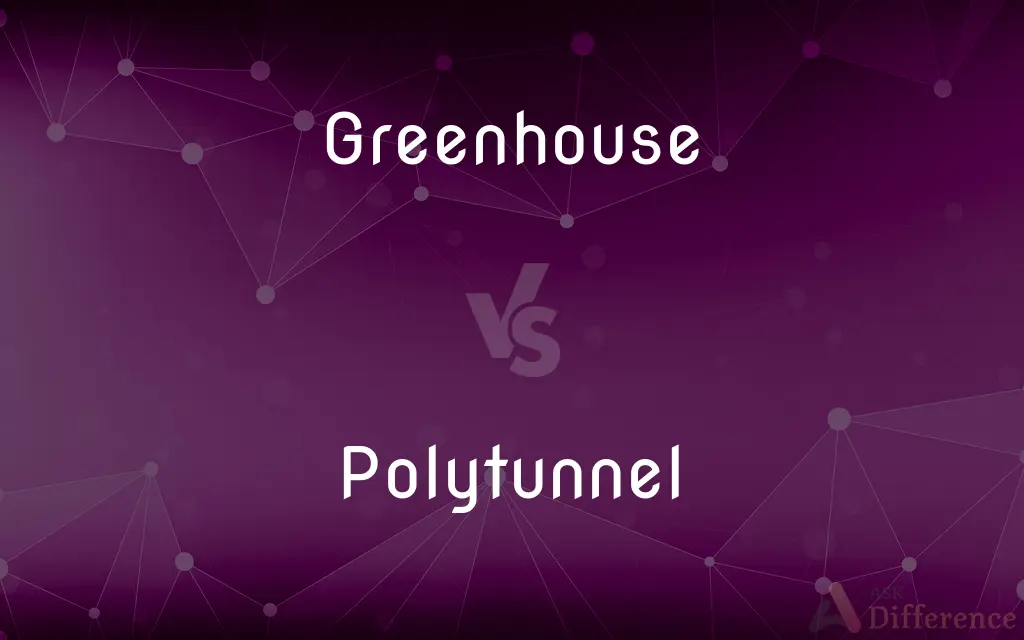Greenhouse vs. Polytunnel — What's the Difference?
Edited by Tayyaba Rehman — By Maham Liaqat — Updated on April 24, 2024
Greenhouses are typically made of glass or hard plastic panels, providing sturdy, year-round growing conditions, wheras polytunnels, made from flexible plastic over a metal frame, offer a more cost-effective, seasonal solution.

Difference Between Greenhouse and Polytunnel
Table of Contents
ADVERTISEMENT
Key Differences
Greenhouses are constructed with glass or rigid polycarbonate panels that provide excellent light transmission and durability. They often feature permanent structures with a foundation. On the other hand, polytunnels are covered with a layer of flexible, translucent polyethylene that is stretched over a series of metal hoops, making them easier to construct and dismantle as needed.
While greenhouses are better at retaining heat due to their solid construction, making them ideal for growing a wide variety of plants year-round, polytunnels can experience greater temperature fluctuations, which may require more frequent adjustments in ventilation to manage heat and humidity effectively.
Greenhouses often come equipped with options for installing heating, cooling, and lighting systems, making them more adaptable to different types of gardening and more consistent in results. Polytunnels, however, are generally simpler setups without built-in systems, relying more on natural conditions and manual adjustments.
In terms of cost, greenhouses are typically more expensive due to their materials and construction complexity. Polytunnels offer a more economical alternative, with lower initial investment and maintenance costs, although they may not last as long as greenhouses.
The choice between a greenhouse and a polytunnel often depends on the gardener’s budget, the climate, and the types of plants they wish to cultivate. Greenhouses provide a more controlled environment, whereas polytunnels are better suited for larger, seasonal crop production that doesn't require as much temperature control.
ADVERTISEMENT
Comparison Chart
Material
Glass or rigid plastic
Flexible polyethylene
Structure
Permanent with foundation
Semi-permanent with no foundation
Climate Control
Can be equipped with heating and cooling systems
Generally lacks built-in climate control systems
Cost
Higher initial cost and maintenance
Lower initial cost and maintenance
Suitability
Year-round use for various plants
Seasonal or specific-climate use
Compare with Definitions
Greenhouse
Primarily designed to protect tender or out-of-season plants against excessive cold or heat.
She extended her growing season by using a greenhouse.
Polytunnel
More adaptable and easier to move compared to a greenhouse.
They moved the polytunnel to cover a different part of the garden each season.
Greenhouse
A structure with walls and roof made chiefly of transparent material, used to grow plants under controlled conditions.
The orchids thrived in the controlled climate of the greenhouse.
Polytunnel
Provides a microclimate to extend the growing season of various crops.
The polytunnel allowed them to harvest spinach throughout the winter.
Greenhouse
Can be used for growing plants in winter or for starting seedlings early.
They used the greenhouse to start the seedlings in early spring.
Polytunnel
A tunnel made of steel hoops covered in polythene, used for growing vegetables or fruits.
They grew tomatoes and cucumbers in the polytunnel.
Greenhouse
May serve as a more permanent fixture in a garden or commercial farm.
The large greenhouse served as the centerpiece of the botanical garden.
Polytunnel
Typically lacks the sophisticated systems found in greenhouses.
Ventilation in the polytunnel was managed by manually rolling up the sides.
Greenhouse
Often equipped with accessories like shading, heating, and cooling systems.
The greenhouse was fitted with fans to cool down the summer heat.
Polytunnel
Suited for larger scale production within certain seasons.
The polytunnel was used to grow a large crop of strawberries in the summer.
Greenhouse
A greenhouse (also called a glasshouse, or, if with sufficient heating, a hothouse) is a structure with walls and roof made chiefly of transparent material, such as glass, in which plants requiring regulated climatic conditions are grown. These structures range in size from small sheds to industrial-sized buildings.
Polytunnel
A polytunnel (also known as a polyhouse, hoop greenhouse or hoophouse, grow tunnel or high tunnel) is a tunnel typically made from steel and covered in polyethylene, usually semi-circular, square or elongated in shape. The interior heats up because incoming solar radiation from the sun warms plants, soil, and other things inside the building faster than heat can escape the structure.
Greenhouse
A glass building in which plants that need protection from cold weather are grown.
Polytunnel
A tunnel made of polyethylene, used to grow plants that require a higher temperature and/or humidity than that which is available in the environment.
Greenhouse
A structure, primarily of glass or sheets of clear plastic, in which temperature and humidity can be controlled for the cultivation or protection of plants.
Greenhouse
(Slang) A clear plastic bubble or shell covering part of an aircraft.
Greenhouse
A building used to grow plants, particularly one with large glass windows or plastic sheeting to trap heat from sunlight even in intemperate seasons or climates.
Greenhouse
The glass of a plane's cockpit.
Greenhouse
(medicine) A structure that shields the operating table to protect against bacteria.
Greenhouse
(climatology) A hot state in global climate.
Greenhouse
(transitive) To place (plants) in a greenhouse.
Greenhouse
To nurture in order to promote growth.
Greenhouse
A house in which tender plants are cultivated and sheltered from the weather.
Greenhouse
A building with glass walls and roof; for the cultivation and exhibition of plants under controlled conditions
Greenhouse
Of or relating to or caused by the greenhouse effect;
Greehouse gases
Common Curiosities
What type of structure is a greenhouse?
A greenhouse typically has a permanent, sturdy structure with a foundation.
Can you grow plants in a polytunnel year-round?
While it's possible in milder climates, polytunnels are generally better suited for seasonal use due to less insulation and climate control.
What are the typical uses of a greenhouse?
Greenhouses are primarily used for growing delicate plants that require specific temperature and humidity levels, propagating seedlings, and cultivating crops out of season.
How does the durability of greenhouses compare to polytunnels?
Greenhouses, made with glass or hard plastic, generally offer greater durability and can withstand harsher weather conditions compared to the lighter, more temporary structure of polytunnels.
How can I improve ventilation in a greenhouse?
Ventilation can be improved by installing vents or fans, opening doors and windows, or using automatic vent openers that respond to temperature changes.
What kind of maintenance does a polytunnel require?
Polytunnels require regular maintenance to ensure the plastic cover remains intact and functional, including checking for tears, managing condensation, and ensuring proper ventilation.
What is the main material difference between a greenhouse and a polytunnel?
A greenhouse is made of glass or rigid plastic, while a polytunnel is covered with flexible polyethylene.
How do greenhouses and polytunnels differ in cost?
Greenhouses generally cost more due to their durable materials and the possibility of integrating advanced systems, whereas polytunnels are less expensive.
Which is easier to set up, a greenhouse or a polytunnel?
A polytunnel is easier and quicker to set up due to its simpler, lightweight design.
Can I use a heating system in a polytunnel?
While not as common, it is possible to use portable heating systems in polytunnels to extend the growing season into colder months.
Is a polytunnel suitable for organic farming?
Yes, polytunnels are quite popular in organic farming as they enable extended seasons and better pest management without relying on chemical interventions.
What are the benefits of a greenhouse in urban farming?
In urban farming, greenhouses provide a controlled environment for growing a variety of plants in limited space throughout the year, making them ideal for rooftop and balcony gardens.
How do I choose between a greenhouse and a polytunnel?
The choice depends on your specific gardening needs, climate, budget, and the types of plants you intend to grow. Consider the long-term sustainability and the ability to control environmental factors.
What types of crops are best suited for polytunnels?
Polytunnels are ideal for growing crops that benefit from a warmer climate, such as tomatoes, peppers, and cucumbers, especially extending their growing seasons.
Are polytunnels environmentally friendly?
Polytunnels can be considered environmentally friendly as they use fewer resources and energy compared to some types of greenhouses, though the plastic covers do need to be replaced periodically.
Share Your Discovery

Previous Comparison
Beautiful vs. Handsome
Next Comparison
Merchandiser vs. MerchantAuthor Spotlight
Written by
Maham LiaqatEdited by
Tayyaba RehmanTayyaba Rehman is a distinguished writer, currently serving as a primary contributor to askdifference.com. As a researcher in semantics and etymology, Tayyaba's passion for the complexity of languages and their distinctions has found a perfect home on the platform. Tayyaba delves into the intricacies of language, distinguishing between commonly confused words and phrases, thereby providing clarity for readers worldwide.
















































